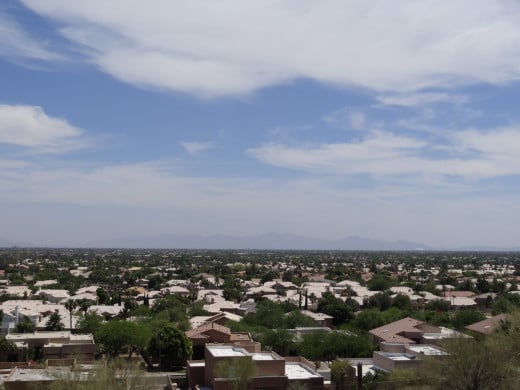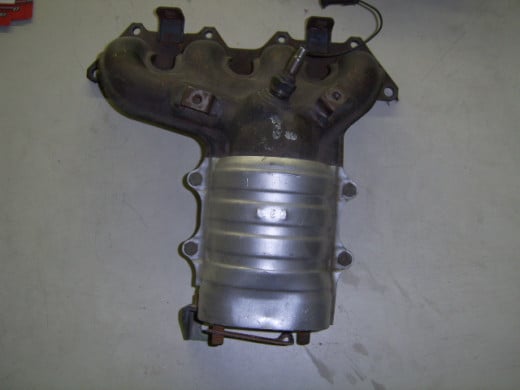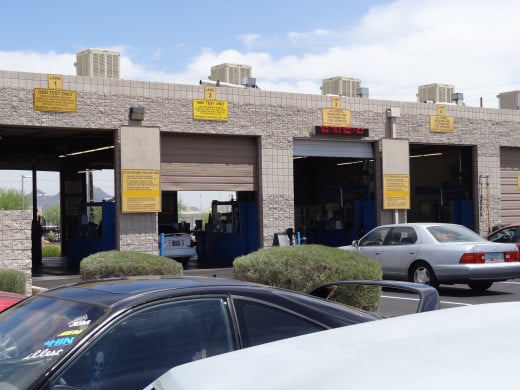DIY Auto Service; US EPA and EU (European Union) Emissions and Testing
Smog

Environmental Protection Agency (EPA)
The US Environmental Protection Agency (EPA) was created by the National Environmental Policy Act is responsible for monitoring, regulating and enforcing the management of the condition of our air, water and ground. The United States Clean Air Act in 1963 was designed to control air pollution on a national level. The state of California and its “California Air Research Board” (CARB) set standards that must be met in the state of California. The CARB standards are typically more stringent than the EPA standards. A number of other states have adopted the CARB standards.
Other parts of the world have adopted emission standards as well. The European Union (EU) has its own set of emission standards similar to the US EPA and CARB levels. The standards are referred to as Euro 1 – 6. Many other countries such as China have adopted their own standards based on the EU standards, especially in Beijing, China. The pollution levels in Beijing were a concern for the 2008 Olympic Games and Beijing enacted standards similar to the Euro 4 standards before the Games.
Truck and Trailer Systems Textbook
Vehicle Emissions
The emissions in the exhaust stream of our vehicles and equipment are produced by the combustion in the engine cylinders. Depending on the fuel type and engine design, the emission levels are different. The main emissions that are of concern are; nitrogen oxides (NOx), hydrocarbon (HC), carbon monoxide (CO) and particulate matter (PM). Carbon dioxide is considered a greenhouse gas but is not part of the emissions being targeted by vehicle emission levels (yet). Burning alternative fuels and increasing fuel economy (burns less fuel) will produce less CO2.
Nitrogen Oxide (NOx)
NOX also referred to as Oxides of Nitrogen, is formed by high temperatures in the engine combustion chambers. The air is made up of about 78% nitrogen and 20% oxygen. Under extremely high cylinder temperatures produced by lean air fuel mixtures, typically above 2,500°F, NOx is formed by combining the nitrogen and oxygen together. The NOx then combines with sunlight to produce photochemical smog. This is especially a problem in high density metropolitan areas. Some of the areas like Los Angeles, California have environmental conditions that make the problem even worse. The mountains and hills around Los Angeles cause the air to pass over and not carry away the pollution. This is one of the reasons for the CARB. Most of the larger cities have a problem with smog. From a distance, some cities like Denver, Colorado look as if they have a protective brown dome over the city from the smog.
NOx Reduction
To reduce the production of NOx, cylinder temperatures must be reduced. A richer mixture could reduce the temperatures but this would cause the other emissions to go up. The solution is an Exhaust Gas Recirculation (EGR) system. This is done by taking some of the exhaust gas that has already been burned and introducing it back into the cylinder. Since this gas has already been burned it is referred to as being inert and it will not burn again. The EGR gas takes up space and will expand with the other gasses in the cylinder. Since the gas will not burn, it will not cause the cylinder temperature to go up. If the cylinder temperature is kept below the threshold, lower NOx levels are produced.
After January 1st 2010, most medium and heavy duty diesel engine manufacturers added Selective Catalytic Reduction (SCR) systems to their engines. Combine this engine exhaust with Selective Catalyst Reduction (SCR Converter) and the NOx levels are extremely low. The catalyst separates the nitrogen and oxygen by using a catalyst that causes the change. Diesel Exhaust Fluid (DEF) systems add urea to the exhaust to aid in the conversion of the NOx to nitrogen and water (H2O).
Hydrocarbon (HC)
Hydrocarbon emissions are the raw fuel that has not been through the combustion process at all. If there are hydrocarbon emissions coming out of the combustion chamber, we have to wonder why. How did the raw fuel make it through the cylinder. Typically this is from bad cylinder combustion or a misfire. On a gasoline or propane fueled engine, the ignition spark plug may not have ignited the air/fuel mixture. Low compression on a diesel engine could cause the lack of heat and pressure required to ignite the diesel fuel. An extremely rich mixture could cause high HC’s on either engine model.
Most engines, both diesel and gas, run very lean air /fuel mixtures today to reduce carbon monoxide (CO) and HC emissions. For HC’s to make it through the cylinder something malfunctioned in the combustion process. Typically to diagnose an HC problem, a cylinder performance or cylinder cancel tests is performed to identify the problem cylinders. The engine is probably also running rough due to the misfire.
Carbon Monoxide (CO)
Carbon monoxide (CO) is a poisonous gas produced at higher levels typically due to a rich mixture or incomplete combustion. It is typically formed when the fire in the cylinder is extinguished due to a lack of air for combustion. It occurs like shutting the vents on a charcoal grill. There was still plenty of fuel but the fire went out. As stated earlier, most engines today run very lean mixtures to reduce the amount of CO produced from the lack of oxygen. Diesel engines typically produce very low levels of CO because of the extremely lean mixtures in the diesel cylinders.
Caution: Carbon monoxide is a poisonous gas. Do not run vehicles in a closed area as the levels can become fatal.
Carbon Dioxide (CO2)
Carbon dioxide (CO2) is formed by normal combustion (fire). Higher levels of CO2 and lower levels of CO are signs of good combustion in an acceptable air fuel ratio. CO2 is said to be a greenhouse gas and a contributor to Global Warming. Although there are no standards for CO2 emissions on vehicles (yet), reducing the amount of fuel burned by increasing fuel economy is one of the ways to reduce the production and effect of CO2. Burning a cleaner fuel like biodiesel, liquefied natural gas (LNG), compressed natural gas (CNG), propane or hydrogen are ways to reduce the CO2 production. This is reducing the “Carbon Footprint” produced by vehicles. Some other major producers of CO2 are coal fired power plants. Many of these power plants will be switching to natural gas or be shut down as the EPA lowers the limits for CO2.
Catalytic Convertor

Diesel Fuel Emissions
Particulate Matter (PM)
Years ago it was not uncommon to see a diesel truck billowing clouds of black smoke out of the stack. The black smoke was the product of a rich mixture and leftover soot. Diesel fuel’s power comes from the paraffin (candle wax) in the fuel. When a candle is burning and then blown out, black soot is left behind. This black soot is the particulate matter that is also left over when diesel fuel is burned. This soot is classified as a carcinogen and limits are specified for the year of the engine production.
Like the specified levels of CO, NOx and HC’s, PM levels allowed have been incrementally reduced over the years. The EPA 07 levels mandated the use of a diesel particulate filter (DPF) for the on-road diesel engines. The DPF filters the exhaust and catches the particulates. Over time this filter will get plugged up and require regeneration or cleaning. Regeneration can be done passively (automatically) while driving or manually with the vehicle stationary and the switch engaged.
Sulfur (S)
Sulfur in the fuel can poison the new emission devices for the EPA 2010 models. All of the sulfur in the fuel is oxidized and the oxidation of sulfur (SO2) gives sulfur trioxide (SO3), which reacts with water to give sulfuric acid (H2SO4), a contributor to acid rain.
The reduction of sulfur will reduce standard diesel fuel sulfur levels from about 3,000 parts per million (ppm) to 15 ppm when fully implemented (a reduction of greater than 99 percent). Reducing the sulfur in the fuel was done in two increments called; Low Sulfur Diesel Fuel (LSD) and in 2007 and later vehicles are mandated by law to use Ultra-Low Sulfur Diesel Fuel (ULSD).
The on-road (highway) sulfur reduction breakdown is;
-
Standard diesel fuel – 3,000ppm before 2003
-
Low Sulfur Diesel Fuel (LSD) 500ppm up until 2007
-
Ultra-Low Sulfur Diesel Fuel (ULSD) – 15ppm in 2007 and later models
The nonroad (off-road) sulfur reduction breakdown is;
-
Standard diesel fuel – 3,000ppm before 2007
-
Low Sulfur Diesel Fuel (LSD) 500ppm from 2007 to 2010
-
Ultra-Low Sulfur Diesel Fuel (ULSD) – 15ppm in 2010 and later models
Locomotive and marine diesel fuel will meet the second step as of 2012.
Emission Test Station

Vehicle Emission Testing
Vehicle Emission Testing is required in many counties and cities across the US. Most of the areas that require vehicles to be tested are higher population areas such as around major cities.
The emissions test consists of testing components like your gas cap and fuel tank or EVAP (evaporative) system integrity. The gasoline vapors are not allowed to “evaporate” into the air. . Depending on the year of your vehicle, the test may also include a test drive on the Dyno and the computer system is checked for stored malfunctions.
The emissions that are reported on your emission test results include:
- CO = Carbon Monoxide, poisonous gas.
- HC = Raw fuel
- NOX = Oxides of Nitrogen
The test has parameters for each of these emissions and compare your vehicle against these parameters. Depending on the year of your vehicle has to meet different levels of emissions. As an example a 1970s vehicle levels of emissions are much higher than that of an 80's and progressively continue to be lowered as the vehicle model year increases to today's vehicles.
In the middle 90's the EPA (Environmental Protection Agency) implemented a set of standards that all the vehicles in the US had to meet. It is referred to as OBD II or onboard diagnostics 2nd generation and was mandated on all 96 or newer vehicles. Before this, each manufacturer was doing their own thing as far as trouble codes, information access and diagnostic routines.
If you have 95 or older vehicle the test requires a sniffer pipe be placed in your tailpipe to measure emissions. Late model vehicles do not need a tailpipe test because the engine computer does monitor the emissions and will turn on the "Check Engine" or "Service Engine Soon" light if there is a malfunction. The test is done by checking the Onboard engine computer for any Trouble Codes.
If your vehicle meets the emission standards you receive a Pass on the test results. This usually will mean you won’t have to be tested for two years. If your vehicle does not meet one or more of the standards you will receive a Fail on the report.
Passing the Emission Test is usually a requirement for license registration. If your vehicle does not pass and you have spent a given amount of money trying to repair it, you may have the option of a onetime waiver.









